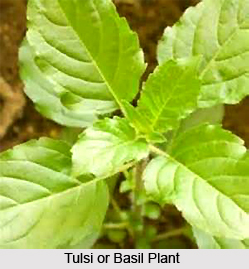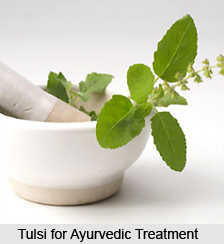 Female diseases cured by Tulsi or `basil plant` are numerous and Tulsi has proven its efficacy in successfully eradicating issues associated to conception, menstruation and others. The sacred basil plant is highly revered as one of the most significant medicinal plants which grow in the country. Women are prone to several types of physical and psychological disorders, which can be alleviated with the judicious consumption or application of Tulsi. Various kinds of Ayurvedic decoctions and solutions, mixed with different forms of Tulsi enable patients to enjoy relief from issues like excessive labour pain, skin ailments, abnormal bleeding during menstruation, other menstrual problems and so on.
Female diseases cured by Tulsi or `basil plant` are numerous and Tulsi has proven its efficacy in successfully eradicating issues associated to conception, menstruation and others. The sacred basil plant is highly revered as one of the most significant medicinal plants which grow in the country. Women are prone to several types of physical and psychological disorders, which can be alleviated with the judicious consumption or application of Tulsi. Various kinds of Ayurvedic decoctions and solutions, mixed with different forms of Tulsi enable patients to enjoy relief from issues like excessive labour pain, skin ailments, abnormal bleeding during menstruation, other menstrual problems and so on.
Tulsi for Controlling Menstrual Problems
A majority of women experience painful menstrual periods, accompanied by severe cramps in their stomachs and lower back and excessive bleeding. A mixture composed of five portions of Tulsi powder, `ajwain` seeds, `tamal patra`, gum obtained from neem tree and 2 gms of dried ginger boiled in 100 gms of water should be consumed to ease bleeding. One must consume it after permitting the concoction to cool. Irregular menstruation can be healed by taking dried roots of Tulsi, grinding them into powder and consuming it with beetle vine over a period of one month.
Tulsi for Easing Conception Complications
Patients should consume half a glass of water boiled with leaves of Tulsi plant for each of the three days starting from the day of menstruation, to eliminate the possibility of conception. Internal bleeding of the stomach is promptly checked by the usage of powdered roots of Tulsi wrapped in betel leaves. Consumption of various decoctions of Tulsi ensures good health of the uterus, while drinking Tulsi juice would help reduce the excruciating labour pains. Labour pains after delivery can be eased if an expecting mother consumes a mixture of sugar, water and Tulsi seeds which have been soaked overnight for over twelve hours. To conceive, one must take a mixture of `shatavary`, saffron, `gangeran`, `putrakanda`, `dhro` grass and five parts of Tulsi plant. However, sugar and milk obtained directly from a cow must be added to it and utilized for ten days, starting from the day of menstruation.
 Tulsi for Ailments during Pregnancy
Tulsi for Ailments during Pregnancy
Itching of the skin over the abdomen and the breasts of a pregnant woman is relieved by the application paste of `Van Tulsi`. Application of medicated oil prepared with 125 gms of Van Tulsi leaves in 500 gms of sesame oil previously subjected to the process of `moorchhana`, relieves the pains associated with confinement. Breast milk will improve in quality if the woman is given a mixture of 20 gms of Tulsi juice, 20 gms of the juice of maize leaves, 10 gms of the juice-or extract of `asgandh` or `ashwagandha`, and 10 gms of honey, for seven days following delivery.
Tulsi for Curing Hormonal Imbalance
The issue of hormonal imbalance is a source of anxiety for innumerable women and young, adolescent girls, which might fuel certain complicated physical conditions. Frequent mood swings, weight-gain, menstrual issues, a suddenly reduced libido, muscular cramps, fatigue, insomnia and dull musculoskeletal are some of the consequences of hormonal imbalances. The hormone named `Cortisol` released by adrenal glands, particularly during moments of intense stress can be controlled by proper intake of Tulsi. Tulsi and ginger are empowered to balance the levels of Cortisol in the body. Besides, Tulsi is also believed to affect the secretion of dopamine and serotonin into the brain. This indirectly enables one to stay stress-free and calm, since these neurotransmitters regulate psychological health and mood.
Tulsi for Treating Breast Cancer
Several medical practitioners also believe in the capability of Tulsi plant to relieve breast cancer in women. Tulsi tea must be consumed regularly to cure breast cancer, as per the accounts of doctors. Two cups of boiling water must be poured over 10 or 15 fresh holy basil leaves and then the leaves must be removed prior to its consumption.
Other Medicinal Utilities of Tulsi for Womens` Maladies
Leucorrhoea can be completely cured by treatment with 20 gms of Tulsi juice with rice water, meanwhile restricting the diet to rice and milk, or rice and ghee for the duration of the treatment. Regular periods can be restored by 125 gms of Tulsi seeds, black sesame seeds, tender shoots of the cotton plant, tender shoots of bamboo plants and 220 gms of aged jaggery mixed with the powder. This is effective even in cases of women with amenorrhoea.



















